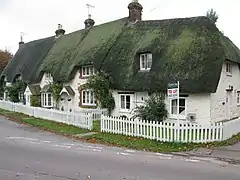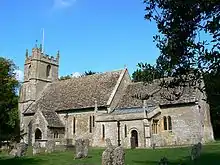Broad Hinton
Broad Hinton is a village and civil parish in Wiltshire, England, about 5 miles (8 km) southwest of Swindon. The parish includes the hamlets of Uffcott and The Weir.
| Broad Hinton | |
|---|---|
 | |
 Broad Hinton Location within Wiltshire | |
| Population | 650 (in 2011)[1] |
| OS grid reference | SU105765 |
| Civil parish |
|
| Unitary authority | |
| Ceremonial county | |
| Region | |
| Country | England |
| Sovereign state | United Kingdom |
| Post town | SWINDON |
| Postcode district | SN4 |
| Dialling code | 01793 |
| Police | Wiltshire |
| Fire | Dorset and Wiltshire |
| Ambulance | South Western |
| UK Parliament | |
| Website | Broad Hinton Village Hall |
Disambiguation
This village of Broad Hinton near Swindon should not be confused with Broad Hinton, a liberty in the civil parish of Hurst, Berkshire. That part of Hurst was a detached part of Wiltshire until the Counties (Detached Parts) Act 1844 transferred the liberty to Berkshire.
Governance
Broad Hinton elects a joint parish council with the smaller adjacent parish of Winterbourne Bassett – see Broad Hinton and Winterbourne Bassett.
The village is in West Selkley electoral ward. This ward starts in the north at Broad Hinton, stretches around but not into Marlborough, and ends at Savernake in the south. The ward population taken at the 2011 census was 4,327.[2]
Archaeology
There are several barrows in the parish, notably on Hackpen Hill.[3] East of The Weir is a Romano-British burial site and possibly the remains of a house of that period.[3]
Bincknoll Castle is an earthwork on a promentary on a chalk escarpment in the northernmost part of the parish.[3] It is the remains of a fortified enclosure, possibly Romano-British in origin, that was re-used in the Middle Ages.[3]
Manor
The Domesday Book of 1086 records that a man called Ranulph held the manor of Broad Hinton.[3] It then passed to the Wase family and became known as Hinton Wase.[3] In 1365 Nicholas Wase sold the manor to William Wroughton (died 1392), whose family then held Broad Hinton until 1628 when Sir Giles Wroughton sold it to Sir John Glanville, MP and later Speaker of the House of Commons.[3] He was a cousin of John Evelyn's wife and the diarist visited him at Broad Hinton in 1654, noting that he was living in the manor's gatehouse because he had burnt down his home to prevent the Roundheads setting up a garrison there during the Civil War. In 1709 a later John Glanville sold the manor to Thomas Bennet, from whom it descended via the female line through the Legh, Keck and Calley families.[3] In 1839 James Calley sold Broad Hinton to the Duke of Wellington.[3] In 1867 his son the 2nd Duke of Wellington sold Broad Hinton to N. Story-Maskelyne, who in 1869 sold it on to the former MP Sir Henry Meux, 2nd Baronet.[3] Sir Henry died in 1900 and his widow Lady Meux had the manor broken up and auctioned in several lots in 1906.[3]
Parish church

The Church of England parish church of Saint Peter ad Vincula ("St Peter in Chains") is one of only 15 churches in England with this dedication, which is in honour of the Basilica of San Pietro in Vincoli in Rome.
The earliest parts of the church building date from late in the 12th century.[3] They include an Early English Gothic priest's doorway,[4] which was later moved from the chancel to the organ chamber.[3] In the 13th century the chancel was rebuilt, the nave was altered and the church was dedicated to Saint Mary.[3] The Perpendicular Gothic tower[4] was built in the 15th or early in the 16th century.[3] A rood stair was inserted early in the 16th century.[3] The nave was re-roofed in 1634 and the east end of the chancel was altered or rebuilt in the 18th century.[3]
In the 19th century the church was called St. Peter's. The building was restored in 1879 to plans by the Gothic Revival architect C.E. Ponting of Marlborough.[3] He had a new, wider chancel arch built and re-used the old one to link the chancel with the organ chamber.[3] In 1958 the church was designated as Grade I listed.[5]
Monuments
The church contains several imposing monuments, notably to members of the Wroughton and Glanville families.[6]
There are indents of two lost brasses in the chancel, both knights in armour. The earlier was probably to William Wroughton (died 1392) and the later was certainly to his grandson, John Wroughton (died 1429).
The monument to John's great great grandson, Sir William Wroughton (died 1559), is early Elizabethan, canopied, and shows influence of the previous Perpendicular Gothic style.[6] Despite an inscription in praise of Queen Elizabeth, it includes subtle references to his Roman Catholic sympathies. The monument to his son, Sir Thomas Wroughton (died 1597) and his wife, is a large standing monument, with figures of Sir Thomas and Lady Wroughton kneeling in prayer and facing east.[6] An old legend tells how Sir Thomas is shown with no hands because they withered away after he threw his wife's Bible in the fire. He had returned home from hunting to find her reading it rather than making his supper and was not best pleased.
Colonel Francis Glanville, a younger son of Speaker Glanville, was a Royalist soldier in the English Civil War.[3] He was killed in 1645 when a Parliamentarian force besieged the Royalist-held town of Bridgwater in Somerset.[6] His monument at Broad Hinton is a standing alabaster statue, wearing armour and holding the metal staff of a standard.[6] His real armour is displayed above the monument.[6]
Amenities
Broad Hinton has two public houses, The Barbury Inn,[7] a free house, and The Crown Inn,[8] controlled by Arkell's Brewery of Swindon.[9] The village has a village shop and post office[10] and a village hall.[11] Broad Hinton has sports clubs including a cricket club and a badminton club.[12] It has societies including a Women's Institute[12] and an amateur dramatics society.[13]
Broad Hinton Church of England Primary School serves the parish and nearby villages. Beginning in 1743, Thomas Benet, a local landowner, paid for a schoolmaster, and in 1751 he provided a house for the school and teacher to use.[14] A classroom was added in 1845 but in 1847 the older, thatched, part of the school burned down; a new school was immediately built in stone.[3] This became a National School in 1882 and a Voluntary controlled school in the 20th century.[15]
References
- "Wiltshire Community History – Census". Wiltshire Council. Archived from the original on 12 September 2014. Retrieved 12 September 2014.
- "West Selkley ward 2011". Office for National Statistics. Retrieved 17 March 2015.
- Crowley et al., 1983, pages 105–109
- Pevsner & Cherry, 1975, page 146
- Historic England. "Church of St Peter ad Vincula (1365589)". National Heritage List for England. Retrieved 29 February 2016.
- Pevsner & Cherry, 1975, page 147
- "The Barbury Inn – Freehouse – Broad Hinton". Retrieved 12 September 2014.
- "The Crown, Broad Hinton". Retrieved 12 September 2014.
- "Arkell's Pubs: The Crown Inn, Broad Hinton". Arkell's Brewery.
- "New Owners of Broad Hinton Post Office & Stores". Broad Hinton, Wiltshire. Archived from the original on 11 September 2011.
- "Broad Hinton Village Hall". Broad Hinton, Wiltshire. Archived from the original on 11 September 2011.
- "Village clubs, societies and organisations". Broad Hinton, Wiltshire. Archived from the original on 11 September 2011.
- "Broad Hinton Amateur Dramatic Society (BHADS)". Broad Hinton, Wiltshire. Archived from the original on 11 September 2011.
- "Broad Hinton School". Wiltshire Community History. Wiltshire Council. Archived from the original on 7 March 2016. Retrieved 29 February 2016.
- "Broad Hinton Church of England Primary School". Wiltshire Community History. Wiltshire Council. Archived from the original on 7 March 2016. Retrieved 29 February 2016.
Sources
- Crowley, D.A. (ed.); Baggs, A.P.; Freeman, Jane; Stevenson, Janet H. (1983). Victoria County History: Wiltshire: Volume 12: Ramsbury and Selkey hundreds; the Borough of Marlborough. pp. 105–109.CS1 maint: extra text: authors list (link)
- Pevsner, Nikolaus; Cherry, Bridget (revision) (1975). The Buildings of England: Wiltshire. Harmondsworth: Penguin Books. pp. 146–147. ISBN 0140710264.
External links
| Wikimedia Commons has media related to Broad Hinton. |
